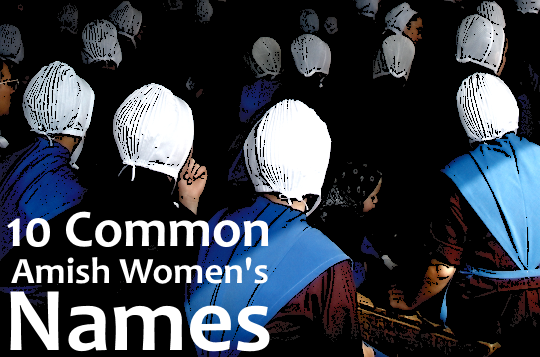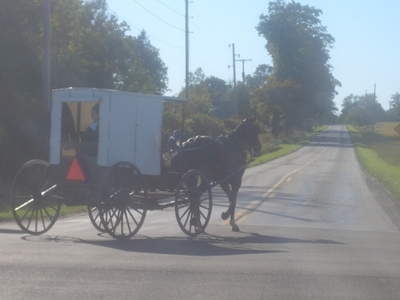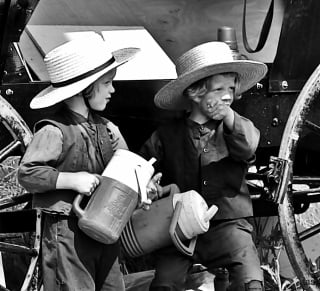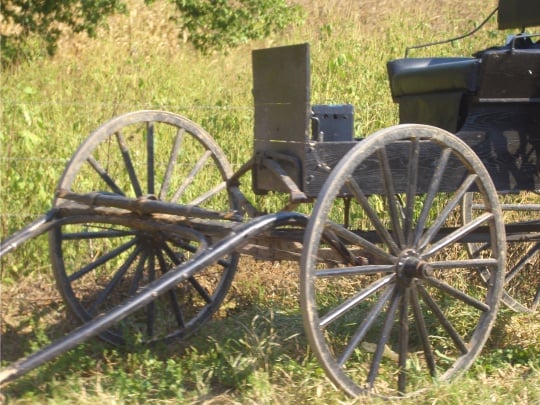Buggy-friendly America
Across America in places where the Amish have set up shop, local businesses and government authorities have had to adapt some practices to accommodate the preferred Amish transportation.
Traffic Jam off County Road 77 in Holmes County, Ohio
Sometimes an Amish group showing up in an area can lead to disputes with locals over horse mess or hoof damage on roads. The smarter businesses, or at least those that hope to attract more Amish customers, usually get a hitching post up in front as soon as possible to make themselves buggy-friendly.
Wal-Mart in Millersburg, Ohio
Road signs warn drivers of the presence of buggies. The designs of such signs are specific to state and even individual community. Stephen Scott’s Plain Buggies contains photographs outlining the differences in buggy warning-sign design in states such as Ohio, Delaware, New York, and Pennsylvania. Generally they all consist of black silhouettes on a yellow background, but with different artists’ renditions of the vehicle. Why the difference? Perhaps due to the fact that they are maintained by state and local authorities rather than a federal body which might be expected to produce more uniform signage.
New Bedford, Ohio
In certain Amish communities, such as that of Allen County, Indiana, the buggy silhouette on local signs is a crude approximation of a topless carriage, as Allen County Amish use only this type.
New Wilmington, Pennsylvania
Most Amish conform to law by utilizing some form of reflectorized material or lighting to warn drivers of their presence. Most find this to be a sensible compromise–they allow their transportation to be adorned with a man-made symbol, yet benefit from increased safety, while promoting the safety of car-drivers as well.
Swartzentruber Amish, Wayne County, Ohio
Interestingly, the Swartzentruber Amish are among the only groups which refuse to use the familiar slow-moving vehicle triangle, while the ‘white-top buggy’ Nebraska Amish, considered by some to be the most conservative of all Amish, choose to use the triangle. The Swartzentrubers have been criticized for this not only by outsiders but by higher-order Amish as well.
Nebraska Amish, Northeast Ohio
At night, bicycle riders will often trail directly behind buggies to benefit from the safety offered by the buggy’s size and blinker system. Some of these buggies are extremely well lit up. Yet lights are not a foolproof measure of protection.
Holmes County, Ohio
I recall stopping my truck at dusk to offer help to an Allen County, Indiana family whose battery had gone out. I had barely seen their darkened open carriage and suggested that I drive behind them to give them a little bit of protection until they reached home. They kindly refused, as apparently they were already near their destination, and the road was just a secondary gravel road. Good it wasn’t a main one.
Near New Wilmington, Pennsylvania
Despite driver awareness, lighting and reflectors, buggies are still frequently involved in accidents with automobiles. I’ve had a few close calls myself. The trickiest thing is underestimating the speed at which they travel.
Buggy lights appear quite similar to car lights–which is good and bad–good, as you realize that something is there, bad in that you often expect whatever it is to be traveling as fast as a car, until you realize that it’s not a car at all.














Hello,
maybe the only way not to be involved in an accident with a buggy would be that the car drivers go slowlier…
Haaaa, those pictures of Ohio…
I can recall at least a couple terrible accidents near Seymour here in Missouri. I am sure there are lots more too.
Emma, you must know Ohio…they bring back great memories for me.
Michelle do you see a lot of Amish traffic near your area?
The Amish in southern Indiana are strictly farmers and merchants. No slow moving vehicle signs, very low oil lamps on the buggies at night and they have their own schools. The link above is to my Flickr site and leads to my Amish set. I’m amazed at your site and the different rules and types of Amish.
Hi Cindy, thanks a lot, I took a look at your photos, they are really really nice. Is this Orange County you are referring to? The Amish settlement at Daviess County, not far from there, is my favorite of all that I’ve visited, partially for nostalgiac reasons.
I wonder if you wouldn’t mind if I posted a few of your photos in a future post, with a link back to your site?
Erik
Erik, it is Orange County, Indiana that I’m talking about. The ones in Daviess County are a little bit different than the ones around here, although it isn’t too far away. We go eat at the restaurant they run in Montgomery, Indiana sometimes.
You may use any pics of mine you want, that’s why I sent you the link. I grew up playing with Amish kids at my aunt’s farm. I love your website, it’s so interesting to learn about the different Amish cultures.
Cindy
HI CAN OR WILL YOU PLEASE SEND ME DIRECTIONS ON WHERE TO FIND THE COMMUNITY? MY HUSBAND AND I DROVE UP AND DOWN 56 YESTERDAY AND WE COULDN’T FIND IT.
TERE
WE LIVE IN JEFFERSONVILLE,IN. SO WE’RE PRETTY CLOSE TO SALEM, PAOLI, AND THAT AREA.
Thank you Cindy, glad to hear. I might post a few of your photos, they are great. The Orange County Amish are quite a bit more conservative than, say those in Daviess, from what I know. Anita Martin, one of the ‘Amish in Poland’ I’ve been writing about, is from that area. All-around friendly, open folks.
Yes, they are very friendly folk, as most of them are merchants and depend on us “English” for business. There is no working in factories around here.
Our Amish are a lot more conservative than the ones in Daviess County, but fit in very well around here. At a gas station one day, an Amish man walked in and the “regulars” (coffee drinkers) saw him, they all said “Hey, Ezra, how’s it going?” They’re wonderful neighbors and I wouldn’t trade them for anything.
Thanks so much for using some of my pictures. Check back from time to time, as I add new ones any time I get a chance to take them. Keep up the good work, this site is great!
i think the point is here that too many people travel at unsafe speeds for anyone cause theyre in to muchof a damned hurry. if you leave early enough you need to rush so. SLOW THE freak down and smell the roses once and a while.
Erik, I never read this instalment before. Quite interesting.
Thank you for linking me over from the entry where I mentioned
the Walmart parking lot picture.
Glad you enjoyed it. Here is an Amish Encyclopedia article on where the Amish shop: https://amishamerica.com/where-do-amish-go-shopping/
CAN SOMEONE HELP ME WITH DIRECTIONS, PLEASE
MY HUSBAND AND I HAVE BEEN LOOKING FOR AN AMISH COMMUNITY THAT SELLS QUILTS, DOLLS, AND SO FORTH, WE THINK THEY WILL BE CHERISHED CHRISTMAS GIFTS FOR OUR FAMILY IN CALIFORNIA . WE HAVE TRIED TWICE TO FIND THE COMMUNITY WE WERE UP AND SR 56 UNTIL IT GOT DARK. WE WERE GOING BETWEEN SALEM AND PAOLI FOR 3 HOURS AND NEVER DID FIND IT. WERE WE SUPPOSED TO TURN RIGHT IN ORLEANS? CAN SOMEONE PLEASE HELP, WE LIVE IN JEFFERSONVILLE,IN.
THANK YOU,
TERE
I see a lot of SMV triangles on buggies along route 11 in St. Lawrence county NY.
I know there is the smaller Norfolk settlement, but even towards Gouveneur and even into Pulaski I see buggies with triangles. Is it possible that North Country Swartzentrubers have given in to the triangle?
If not, what sort of sect are these blue shirted Amish riding the New York/Adirondack Trailways buses and speaking in a derivative of German (I’m not well versed enough to say for sure it’s Pennsylvania Dutch)? I’m mainly just curious about what sort of beliefs they have. (I just started a new job where I’m at the Buffalo and Syracuse bus terminals a good bit and keep seeing them)
I travel by bus maybe once or twice a year and have gone through the Buffalo terminal many times over the years. Most of the Amish I see there or in other terminals are Swartzentruber or the slightly more progressive Troyer Amish.